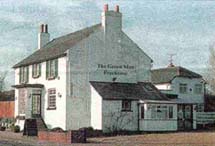The Green Man was built in 1728, in the reign of George 2. It was originally a farm dwelling and comprised a main tenement with stable, outhouses, barn,
hopgrounds, 9 acres of land with 1 acre of wooded land. It was part of the possessions of Christopher Ernest
Kien, of Kensington Palace, a lieutenant colonel of the Horse Guards, who possessed certain estates, the manor of Polton and the hamlet of Shatterling in the parish of Staple. Not long after the house was built he leased part of his estate (including the house) to the Honourable Richard Ingoldsbey of Grosvenor Street, London. He subsequently re-leased this property to Abraham
Larkins, a farmer of Staple.
Christopher Ernest Kien died in 1744 and passed his estate, by the terms of his will, to his widow, Jane. She, in 1758, leased the house and part of her estate to Sumuel Joynes Esq. Of London. In the same year he granted an extension of lease upon the house and its land to Naomi Larkin, widow of Abraham. Jane Kien died in 1762 and passed her estate, by will, to Evert George Cousemaker Esq. Of Westminster. However, he had little benefit from his bequest, for he died in the following year, whereupon his estate passed to his wife Mary, the daughter of Gervas Hayward, merchant and mayor of Sandwich.
Not long after the death of her husband, Mary Cousemaker married her second husband, Sir Thomas Pym Hales, Baronet of Howletts in the County of Kent, whereupon he became possessor of the house and her estate. At this point the house was occupied by the widow Larkin, who is described as her husband was, as a farmer. Sir Thomas Pym Hales died in 1773, and his estate reverted to his wife, Dame Mary Hales. She died in 1788, and her estate passed to her only son from her first marriage, George Kien Hayward
Cousemaker, who is described as a Captain in His Majesty's Foot Regiment of First Guards. At this date, one Joseph White, gentleman of London, was tenant of his estate, whilst the house was in the occupation of Jacob
Larkins.>
George Kien Hayward Cousemaker married the Honourable Catherine Southwell, daughter of the late Edward Lord de Clifford, to whom the estate passed in 1794 upon the death of her husband. She passed it by will in 1797 to her son George. He possessed it until his death in 1820, whereupon it passed to his daughter Sophia. At this date (and for some years prior) there had been an ale house adjacent to this property, called the Green Man, which had once been part of the same estate, but at some time had reverted to Gervas Hayward, Mayor of Sandwich. There had occurred an infringement of the licence of that house and for some time the heirs of Gervas Hayward had petitioned to close it. Upon the achievement of this, a clause was written stating that the property should never be used as an ale house, and it never was again.
(Continued on Next Page)
|



